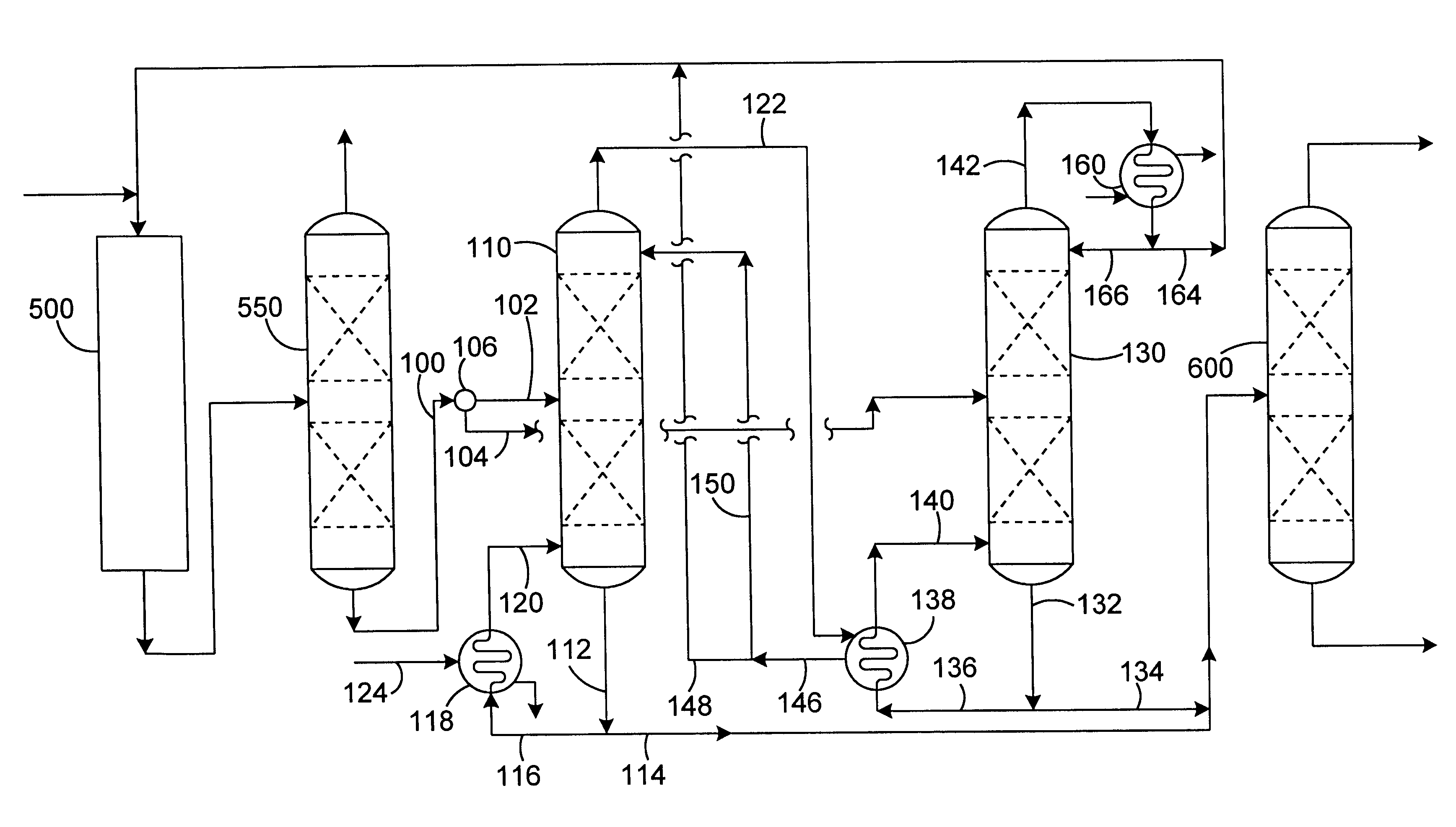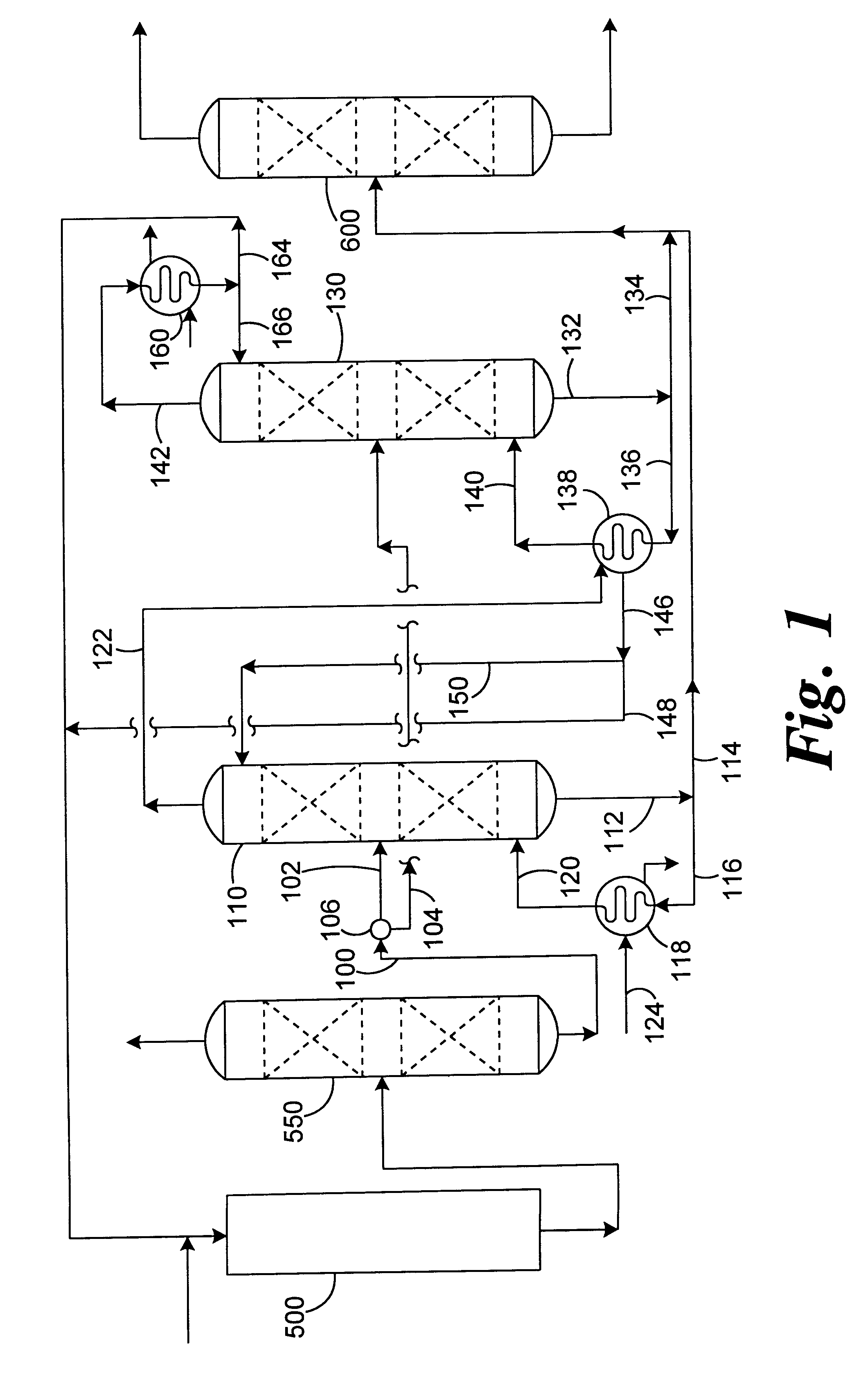Cascade reboiling of ethylbenzene/styrene columns
a technology of ethylbenzene and styrene, which is applied in the field of improved ethylbenzene/styrene columns, apparatus and processes for separating ethylbenzene from styrene monomer, can solve the problems of complex distillation process, difficult separation of styrene monomer from unreacted ethylbenzene, etc., and achieves the effect of reducing
- Summary
- Abstract
- Description
- Claims
- Application Information
AI Technical Summary
Benefits of technology
Problems solved by technology
Method used
Image
Examples
example 2
This example is based on a representative embodiment of the present invention as shown in FIG. 1 wherein a mixed feed comprising ethylbenzene and styrene monomer is split into two process streams for distillation respectively in two cascaded distillation columns operated under different pressure and temperature conditions. The pressures of the columns arc set such that the overhead condensing temperature of one column is higher than the bottoms temperature of the other. Because the overhead vapor from the high-pressure column condenses at a temperature higher than the bottoms temperature of the low-pressure column, this vapor stream can be used as the heat source to the low-pressure column, resulting in surprising process efficiencies and synergisms.
In this example of the present invention, the low-pressure column operates with an overhead pressure of 36 mmHgabs (0.677 psia) and a bottoms pressure of 100 mmHgabs (1.934 psia). At this bottoms pressure, the boiling point of the bottom...
example 3
As previously discussed, in styrene monomer (SM) plants which dehydrogenate ethylbenzene (EB) to styrenie, the reactant ethylbenzene feed is typically converted at a rate of 50 to 70% per pass across the reactor. The unireacted ethylbenlzene must then be recovered and separated from the styrene product prior to recycle to the reaction system. In the reaction section, components lighter than EB and components heavier than styrene are also produced. This mixture of light components, etlhylbenizene, styrene and heavies is typically fed to a distillation train for SM product purification and EB recovery. The general practice is to accomplish these purifications by a three-step distillation.
To separate the above components, the distillation section of a styrene plant typically consists of three independent column systems. The first column in the series recovers the light components such as benzene and toluene (B / T Column) shown schematically in FIG. 1 as column 550; the second column rec...
examples 3 and 4
illustrate the effect of applying the general concept of cascading energy from one column system to another in the conventional three-column series used in the distillation section of a styrene plant but without the novel concept of this invention of splitting the EB / SM stream into two process streams for separate distillation in two cascaded EB / SM distillation columns. For purposes of example 3, the conventional three-column series is adapted to cascade the heat from the overhead vapor of the ethylbenzene / styrene (EB / SM) column (the middle column in the conventional series) to the final column which removes heavies (Finishing Column).
Heat is typically supplied to the finishing column via two independent reboilers. The first, larger reboiler, which provides the majority of the column's heat input, typically operates at low temperature, while the second, smaller reboiler supplies heat at a much higher temperature. The higher temperature service is required to strip heavy polymers fro...
PUM
| Property | Measurement | Unit |
|---|---|---|
| boiling points | aaaaa | aaaaa |
| boiling points | aaaaa | aaaaa |
| pressure | aaaaa | aaaaa |
Abstract
Description
Claims
Application Information
 Login to View More
Login to View More - R&D
- Intellectual Property
- Life Sciences
- Materials
- Tech Scout
- Unparalleled Data Quality
- Higher Quality Content
- 60% Fewer Hallucinations
Browse by: Latest US Patents, China's latest patents, Technical Efficacy Thesaurus, Application Domain, Technology Topic, Popular Technical Reports.
© 2025 PatSnap. All rights reserved.Legal|Privacy policy|Modern Slavery Act Transparency Statement|Sitemap|About US| Contact US: help@patsnap.com


